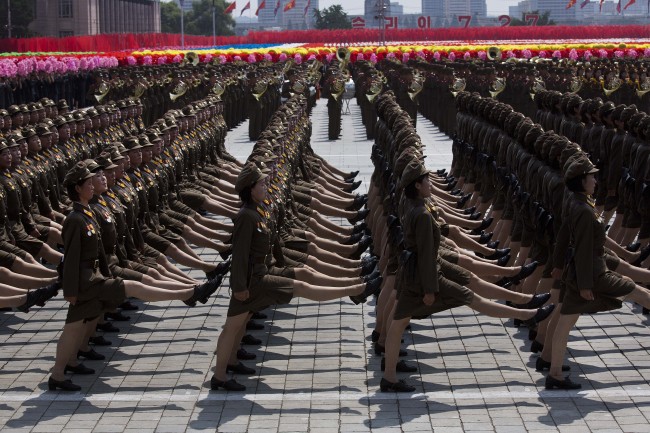PYONGYANG (AP) ― Goose-stepping soldiers, columns of tanks and a broad array of ominous-looking missiles poised on mobile launchers paraded through Pyongyang’s main square on Saturday in a painstakingly choreographed military pageant intended to strike fear into North Korea’s adversaries and rally its people behind young ruler Kim Jong-un on the 60th anniversary of the armistice that ended the Korean War.
The lavish assembly of weapons and troops is reminiscent of the marches held by the Soviet Union and China at the height of the Cold War. It is one of the few chances the world gets to see North Korea’s military up close. Although Pyongyang frequently uses the occasion to reveal new, though not always operational, hardware, there didn’t appear to be any new weapons in Saturday’s parade. Its arsenal of missiles, however, was front-and-center.
The lavish assembly of weapons and troops is reminiscent of the marches held by the Soviet Union and China at the height of the Cold War. It is one of the few chances the world gets to see North Korea’s military up close. Although Pyongyang frequently uses the occasion to reveal new, though not always operational, hardware, there didn’t appear to be any new weapons in Saturday’s parade. Its arsenal of missiles, however, was front-and-center.

Overlooking a sea of spectators mobilized in Kim Il-sung Square to cheer and wave flags, leader Kim Jong-un saluted his troops from a review stand. He was flanked by senior military officials, the chests of their olive green and white uniforms laden with medals. As fighter jets screamed overhead, a relaxed looking Kim smiled and talked with China’s vice president. China fought with North Korea during the war and is Pyongyang’s only major ally and a crucial source of economic aid. Kim did not make a speech.
Kim’s rule, which began in late 2011 after the death of his father, Kim Jong-il, has been marked by high tensions with Washington and Seoul. He has overseen two long-range rocket launches and a nuclear test that drew widespread condemnation and tightened U.N. sanctions.
North and South Korea have turned to tentative diplomacy in recent weeks, but March and April saw North Korean threats of nuclear war against Washington and Seoul in response to annual South Korean-U.S. military drills and U.N. condemnation of Pyongyang’s February nuclear test, the country’s third. Long-stalled North Korean nuclear disarmament talks show no sign of resuming.
Saturday’s parade marks a holiday the North Koreans call “Victory Day in the Fatherland Liberation War,” although the 1950-53 Korean War that refers to ended in a truce and the Korean Peninsula remains technically at war.
Last year’s parade, held to commemorate the April celebrations of the 100th birthday of the late national founder Kim Il-sung, Kim Jong-un’s grandfather, created a buzz among military watchers when the North rolled out a mysterious long-range missile known abroad as the KN-08. Most outside observers now believe the missiles were mock-ups, but they were carried on mobile launchers that appeared to have been obtained from China, possibly against U.N. arms trade sanctions.
Choe Ryong-hae, the army’s top political officer, said North Korea should be ready to fight to defend the stability the country needs to revive the economy. But his speech at Kim Il-sung Square was mild compared with past fiery rhetoric from Pyongyang attacking the United States and South Korea.
Meanwhile, in South Korea, President Park Geun-hye vowed not to tolerate provocations from North Korea ― Seoul says North Korean attacks in 2010 killed 50 South Koreans ― but she also said Seoul would work on building trust with the North. “I urge North Korea to give up the development of nuclear weapons if the country is to start on a path toward true change and progress,” Park said in a speech.
North Korea is estimated to have a handful of crude nuclear bombs, but many analysts don’t think it has yet mastered the technology needed to build warheads small enough to fit on long-range missiles.
About 200 people gathered in Seoul, some burning pictures of the North’s ruling Kim dynasty, at a rally meant “to condemn the nuclear development and threatening strategy of the tyrannical regime of North Korean leader Kim Jong-un,” said Park Chan-sung, an anti-North Korea activist.
Shin Eun-gyeong, who visited an exhibit on the armistice on Saturday at a recently opened history museum, said she wants the rival Koreas to be unified ― but as a democracy, not under North Korea’s autocratic rule. “It’s a real tragedy for Korea that we are still a divided nation,” Shin said.
-
Articles by Korea Herald



















![[Today’s K-pop] NewJeans hits 600m Spotify streams with ‘Ditto’](http://res.heraldm.com/phpwas/restmb_idxmake.php?idx=642&simg=/content/image/2024/05/17/20240517050510_0.jpg&u=)